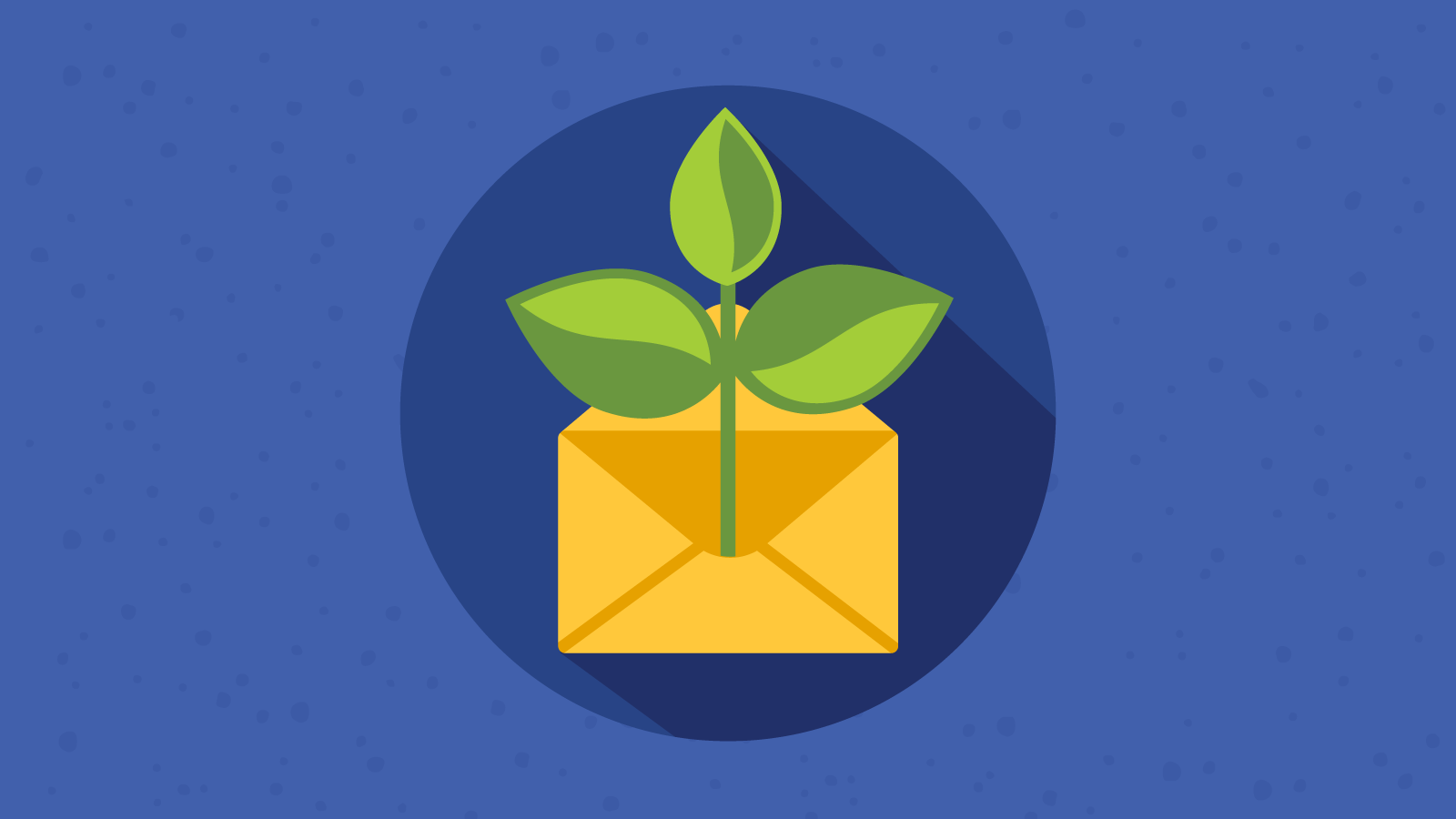Email Marketing
Sustainable Email Marketing: Is There Such a Thing?

Email Marketing

Earth Day should get us all thinking about how our personal lives impact the planet. But what about your work life? Ever wonder what happens when you hit send on a new email campaign? Do those emails leave a carbon footprint?
There was a time when everyone thought email was environmentally friendly because it replaced the use of paper, which saves trees, right? More recently, however, the environmental impact of digital activities has become clearer.
All the little things we do online require energy, and they add up. It’s estimated that internet usage coupled with our devices and supporting systems (like data centers) make up 3.7% of annual global emissions. According to the data on CO2 emissions, if the internet were its own nation, it would be the fifth-largest polluter in the world.
The truth is, all those marketing emails do require the use of energy and fossil fuels. And, it’s possible to waste that energy. So, there’s no better time than now to start thinking about sustainable email marketing.
Let’s take a closer look at what you can do to support a more sustainable approach to email marketing, including an inspiring new initiative.
A few studies have attempted to quantify how much carbon dioxide a single email produces. Citing 2010 research from Mike Berners-Lee’s book, How Bad Are Bananas?, the BBC says the carbon footprint for a typical, personal email is equivalent to 4g CO2 while a message with a hefty attachment could be equal to 50g CO2. Berners-Lee estimated that emails sent by a typical business person in one year would produce enough energy to drive a car 200 miles.
The Berners-Lee research that’s often cited around the internet is now 10 years old, and data centers around the world have become more energy-efficient since then. However, some say the environmental impact of email may have increased over the last decade. Charlotte Freitag, an expert who works for Berners-Lee’s consultancy told the BBC:
We think the footprint per message might be higher today because of the bigger phones people are using.
Of course, it’s not just the act of sending an email that has an environmental impact. Energy is also used to store emails in the cloud as data centers support our overflowing inboxes. That includes plenty of transactional and promotional emails from brands.
While existing research tends to focus on the personal use of email, it’s not hard to make the leap to marketing emails and their potential impact on the climate.
If you’re an email marketer, you see the numbers all the time. Let’s say your campaigns tend to get a 30% open rate. That’s pretty solid. But it also means that 70% of those emails are unopened. And there will be plenty of subscribers who don’t delete those emails either, choosing to ignore and forget about them instead.
After not too long, your email campaign won’t be relevant anymore. Yet those emails take up space on servers, which continues to require energy. And that’s wasteful.
Thankfully, there is hope…

While email marketers could focus on reducing the volume of email being sent, there’s another approach that could reduce email’s carbon footprint.
A growing number of people and organizations are getting behind an innovative idea that supports sustainable email marketing. It’s called the Email Expiration Date initiative.
It’s one of those ideas that is quite simple but stands to make a significant difference.
Imagine if certain obsolete emails automatically disappeared from your inbox after a set period of time. Here’s how it could work:
So, instead of placing all the responsibility on subscribers, email expiration dates would automate everything and reduce email’s carbon footprint in the process.
This project will need widespread support from everyone involved: brands, ESPs, and inbox service providers. But the list of supporters is growing, and it includes Email on Acid as well as our sister brands Mailjet and Mailgun.
Technical specifications for email expiration dates are already in the works. If you care about sustainable email marketing, get involved. Show your support by spreading the word and encouraging others to participate.
Email expiration dates represent an exciting possibility. However, there are some things you can start doing today to make your email marketing efforts more sustainable.
These five tips are relatively easy to do, and they’re also smart marketing habits.
Low open rates and high bounce rates may be a sign that your email marketing could be more sustainable. Sending marketing emails to inactive subscribers and invalid email addresses isn’t just a waste of time, it’s a waste of energy. A reliable list cleansing (aka data scrubbing) service can help with this and so can email verification.
If your open rates are below the industry average, it could be that you’ve got too many people on your list who aren’t interested in what you’re offering. While it’s worth the effort to try and re-engage dormant subscribers, if they don’t respond, you’re better off cutting ties with those contacts. It’s better for the environment too.
Every email you send sits somewhere on a cloud server. If you could reduce your email list from 50,000 to 40,000 with no loss of marketing value, that’s 10,000 fewer emails being sent every time you send to that list. That’s going to add up over time.
Good data hygiene is good for business, too. It will help maintain sender reputation and deliverability rates. It’s smart to conduct list cleanup at least a couple of times a year. Find out more about email list hygiene best practices.
The larger your email, the more storage space it requires and the more energy it takes to send and deliver the message. Email marketers usually don’t send attachments, but we do build emails with plenty of code and imagery.
Images and graphics are important to the visual experiences of your emails and they help you stand out. But they’re also what adds the most to an email’s size. The easiest way to reduce email weight is to optimize images by making the file sizes smaller. You can also get rid of bloated code. Mail Designer 365 offers some advice for making HTML adjustments, including the use of padding instead of spacers.
Imagine cutting just 200kb from an email you sent to 50,000 people. That’s 10,000,000 fewer kilobytes of storage.
Reducing email weight means your campaigns load faster, and that improves the user experience for your subscribers. When it comes to email, instant is everything. If readers have to wait for graphics to load, they’ll likely delete it and move to the next one.
Emails that load in a flash are going to get better engagement. Email on Acid’s Image Validation tool makes it easy to optimize every image and graphic.

In most cases, the batch-and-blast email is a thing of the past. The name of the game is delivering relevant emails to targeted segments of subscribers. You can segment by demographic, customer behavior, industry, and all sorts of other metrics. With 50,000 subscribers on your list, how much energy could you save if it was segmented properly?
If you’re a fashion brand having a sale on women’s shoes, perhaps only the contacts who’ve shown an interest in purchasing those items need to be emailed. If you’re a SaaS company encouraging customers to upgrade, don’t email those who are already paying for your highest-tiered plan.
It’s simple. It makes sense. It just takes a little work to get everything set up. But it will pay off in the long run, and it reduces wasted energy.
Relevance is the key to engagement. Does this email matter to me? That’s what every person asks themselves every time a campaign lands in their inbox. With segmentation and strategic messaging, your email marketing will be more meaningful and effective. As an added incentive, spam complaints tend to arise when emails are irrelevant.
The following situation has happened to me more than once after using the online food delivery service, EatStreet.
I place an order with a local restaurant. It gets confirmed via email. Then, I get an automated apology email notifying me that my order has been canceled for some reason. Maybe the restaurant closed early or stopped taking online orders that day. But, I’m assured my credit card will be refunded.
A little while later, I get another automated email from EatStreet asking me to rate my experience with that local restaurant … from which I’d received nothing. Then, I get a third email asking me to rate my interaction with customer service, which I didn’t really have.
In my opinion, only two of these four emails were necessary — the initial confirmation and the automated apology for the cancellation. I didn’t respond to the two requests for feedback, and I don’t expect EatStreet learns much from customers who do (at least in these situations).
Are there email sequences like this in your strategy? It’s worth taking a look so you can reduce unnecessary email marketing waste.
In addition to reducing your email program’s carbon footprint, you’ll also avoid the possibility of annoying your customers. Email overload is a real problem. If subscribers view your messages as trivial, they’re more likely to ignore you. Every email should have a purpose.
This is another kind of email that may not be unnecessary but is certainly avoidable. Email marketers use the infamous ‘oops email’ for many reasons. Sometimes there’s incorrect information. Other times offensive language inadvertently slips into the copy. It could also be a broken link, an email sent to the wrong list, or a campaign that rendered incorrectly on certain clients.
While the ‘oops email’ has also been used as a sneaky way to get opens, it’s usually nothing more than an embarrassing follow-up in which we admit to making a mistake. Using an automated email checklist during the pre-deployment process helps make sure your emails are perfect before you hit send.
Fewer emails equal less energy usage, which leads to more sustainable email marketing. There’s really no excuse for emails with avoidable mistakes. They needlessly waste energy. But there is something you can do to prevent that during pre-deployment!
Errors in your emails may damage brand reputation, especially if they happen often. Depending on the mistake and the campaign, emails with errors could easily have a direct impact on sales. The cost of email mistakes is no joke. Avoiding the ‘oops email’ saves energy, but it also saves face as well as time and money.
Green marketing of any type may be nothing more than a drop in a huge swimming pool full of things we should do for a cleaner, healthier planet. But those drops start to add up, especially when we all do our part.
Recycling lived up to its promise after a few decades, making a significant and positive impact on the environment. And the world came together to help the ozone layer heal. The responsible decisions of one person or company don’t seem like much, but at the risk of sounding cliche, every little bit helps.
Ultimately, we can save the Earth by rethinking the way we live and consume, which includes email marketing practices. The good news is that a more sustainable email marketing program can also be a more effective one.